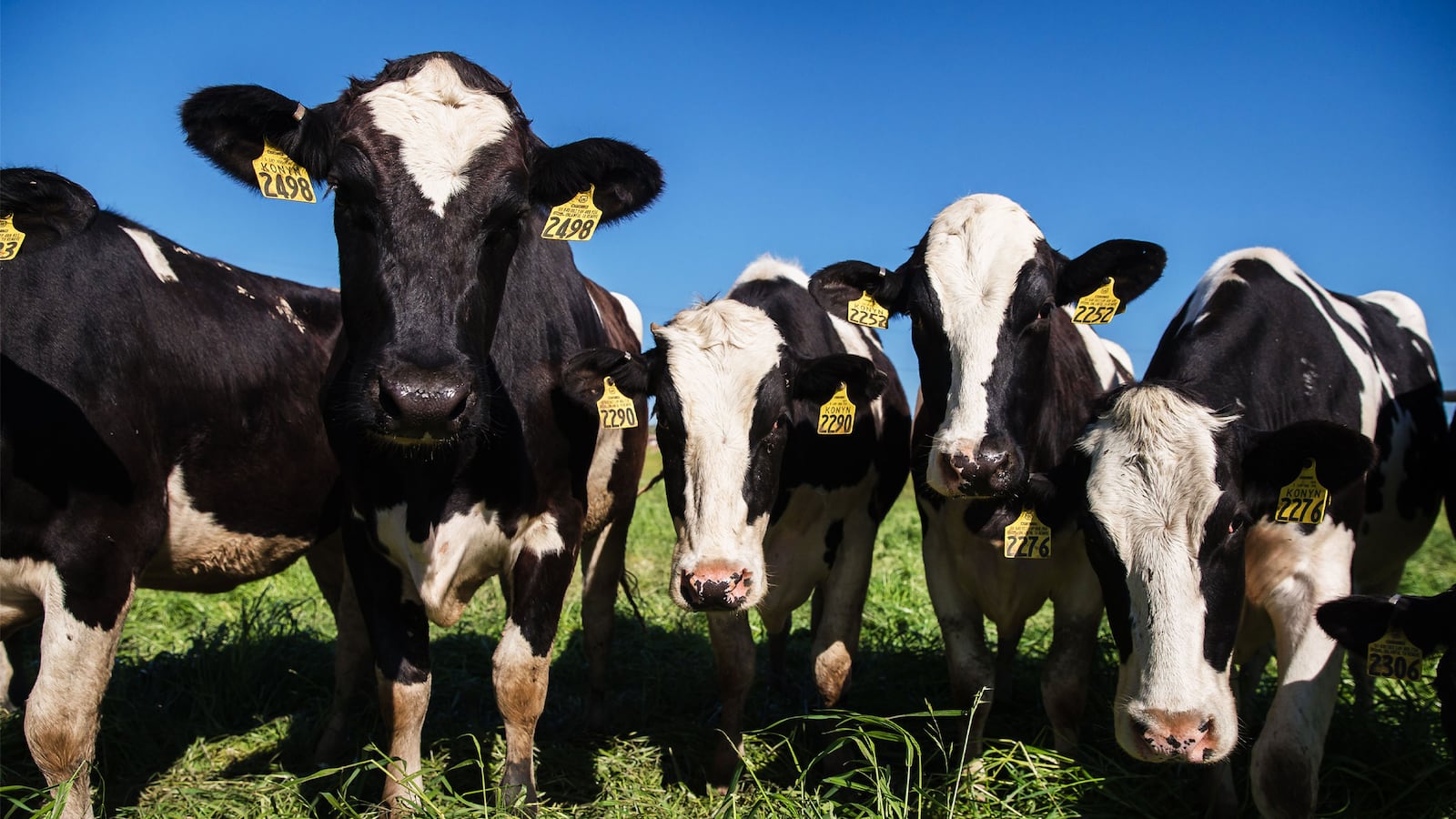In the course of conducting her research on undocumented dairy farm workers, sociologist Julie C. Keller was privy to a call between Mac, a dairy farmer in Wisconsin, and Adulio, a former farmworker, then in Mexico. Adulio asked Mac about the day’s work, chiding him for being behind schedule. He reminded Mac about a group of calves that still needed to be castrated. He told Mac not to worry about the next group, that he, Adulio, would dehorn and castrate them himself, “when I come up….” A listener less familiar with the situation could easily confuse the roles, mistaking Adulio for the farm owner and Mac for the hired hand, rather than understanding the reality: Adulio, 2,000 miles away, preparing to make the journey north, to be smuggled through the border by a coyote, to work on a dairy farm.
The seemingly backward relationship between Adulio and Mac illustrates just how essential undocumented immigrants have become to the dairy industry in the United States. Three recent books—Milking in the Shadows by Keller, The Deportation Machine by Adam Goodman, and Life on the Other Border by Teresa M. Mares—reveal how undocumented dairy farm workers came to be a crucial component of the industry and face even more dire threats than undocumented workers elsewhere, but have nevertheless been organizing to defend themselves.
Undocumented immigrants make up a significant portion of the dairy industry's workforce. Wisconsin, where Keller conducted her research, is second only to California in terms of dairy production, with more than 9,000 farms —40 percent of whose workers are thought to be immigrants, of which more than half are thought to be undocumented. Vermont, where Mares, an anthropologist, focuses her book, dedicates approximately 80 percent of its farmland to supporting dairy production, which accounts for 70 percent of the state’s agricultural sales. The industry provides up to 7,000 jobs, which include at least 1,000 Latino migrants—90 percent of whom are thought to be undocumented.
Dairy farms from Vermont to California rely on undocumented workers to fill local labor shortages, and undocumented workers are attracted to dairy farms due to the stability of the year-round work, as compared to other seasonal farmwork, and the relatively low cost of living, with farm owners often providing housing.
The push and pull that brought, and continues to bring, undocumented workers to dairy farms has both historical and contemporary origins. Mexicans and Mexican Americans have, of course, had an extensive presence in what is today the Southwestern United States but was, prior to the Mexican-American War, part of Mexico. With the end of the war in 1848, the nationality of the land and people changed, as did the migratory patterns of workers. Goodman, a historian, traces how active recruitment by U.S. companies, economic disparities between the United States and Mexico, and the two country’s geographic proximity fueled the migration of Mexican workers to the United States from the turn of the 20th century on.
To control these workers, the United States ran the Bracero Program from 1942 to 1964, authorizing nearly 5 million short-term work contracts for Mexicans, mostly in agriculture. When the program was discontinued, workers’ migratory patterns persisted, albeit through unauthorized channels. In 1965, Lyndon B. Johnson also signed the Hart-Cellar Act, instituting a quota on immigration from the Western Hemisphere into the United States for the first time in its history, further pushing workers into unauthorized immigration channels.
Recent events have brought even more undocumented workers into the U.S. dairy industry. In the ’90s, the North American Free Trade Agreement destabilized the agricultural sector in Mexico, pushing many workers north, to the United States. At the same time, a consolidation of dairy farms in the United States led to larger farms that operated for longer hours and therefore needed more, and more compliant, labor. According to Keller’s research, this supply and demand first connected in the late ‘90s, as dairy farmers began hiring undocumented workers and word spread among Mexican communities about jobs available in the rural Wisconsin, Vermont, and other dairy-producing states. As one worker from Veracruz told Keller about his trip to Wisconsin in the late ’90s: “What happened is that we have friends who told us, ‘Let’s go to a part of Wisconsin because there aren’t many Mexicans over there yet.’”
Along with unique opportunities, undocumented dairy farm workers face unique challenges. They are threatened by the same immigration enforcement as other undocumented immigrants, but the particularities of their industry make them even more vulnerable. Dairy workers, for example, are not eligible for guest worker visas, as other migrant workers in agriculture are, meaning there is no legal way for them to obtain this work (outside of the relative impossibility of becoming residents, of course). Despite making up a vital component of the workforce, undocumented dairy farm workers in Wisconsin and elsewhere are also denied routine necessities like drivers’ licenses and legal protections related to their working conditions and housing—which, as previously mentioned, is often provided by farmers.
With up to 89 percent of immigrant dairy workers hailing from Mexico, they are also uniquely susceptible to racial profiling. Unlike undocumented immigrants in metropolitan areas, who may be able to blend into more diverse populations, undocumented migrant workers typically live and work in rural, ubiquitously white locales. Orleans, Vermont, and Crawford, Wisconsin, are home to a significant number of dairy farms and more than 95 percent of the residents of both counties are white, making undocumented immigrant dairy workers hypervisible and therefore vulnerable to racial profiling.
The rural countryside, lack of access to transportation, heightened visibility, and threat of immigration enforcement come together to turn the dairy farm into a kind of prison, where undocumented workers are trapped by fear. As one worker in Vermont told Mares about her experience on the farm: “I live in an apartment attached to the barn. I used to only leave the apartment to go to the milking parlor to help my husband sometimes. I never went outside. I didn’t see the sun.”
Despite the threats to their livelihoods, undocumented workers in the dairy industry have been organizing to defend themselves. Migrant Justice is a coalition of dairy farm workers in Vermont, which was formed following the grisly death of Jose Obeth Santiz Cruz, a young dairy farm worker who was strangled by machinery in 2009. Since then, Migrant Justice has organized dairy farm workers to lobby the industry for higher employment standards and, more recently, to defend their rights as immigrants. In 2017, the organization celebrated the launch of its “Milk with Dignity” program, through which businesses that rely on Vermont’s dairy industry, such as Ben & Jerry’s Ice Cream, adhere to a worker-authored code of conduct, agree to third-party monitoring, and pay a small premium on milk directly to workers.
On the political front, Migrant Justice has been involved in securing driver’s licenses for undocumented immigrants in Vermont, passing the state’s bias-free policing policy barring state police from asking about immigration status, and providing “Know Your Rights” training for immigrants interacting with law enforcement. The organization has also been at the forefront of defending undocumented dairy farm workers detained by ICE.
While Migrant Justice’s efforts remain focused on Vermont, there is hope that the model of dairy farm workers organizing to defend themselves will take off in other dairy-producing states, like Wisconsin. After all, Migrant Justice was modeled on the Coalition of Immokalee Workers, which organizes undocumented workers in Florida’s tomato industry, so similar efforts are multiplying as workers realize their shared predicament—as well as their power. As one undocumented dairy farm worker and member of Migrant Justice told Mares in Vermont:
<p>I never imagined I would be an organizer, I came here to work with my family, that was my goal, to help my family in Mexico... The first time I went to an assembly with Migrant Justice, I really wanted to meet a group of workers, and I get there and I am hearing the same stories of my friends that are like mine, like they also can’t leave their homes, so that taught me a lot.</p>







